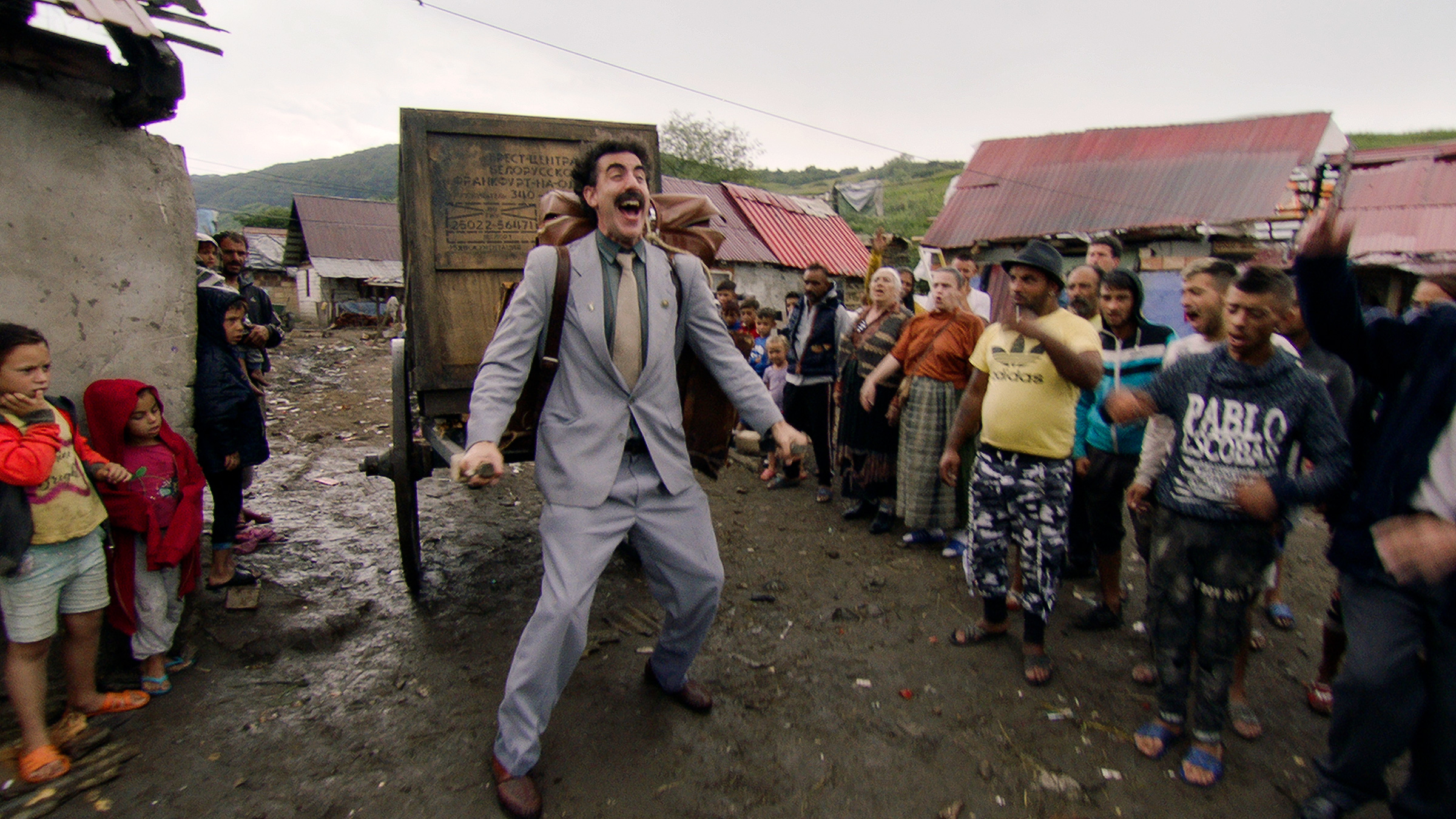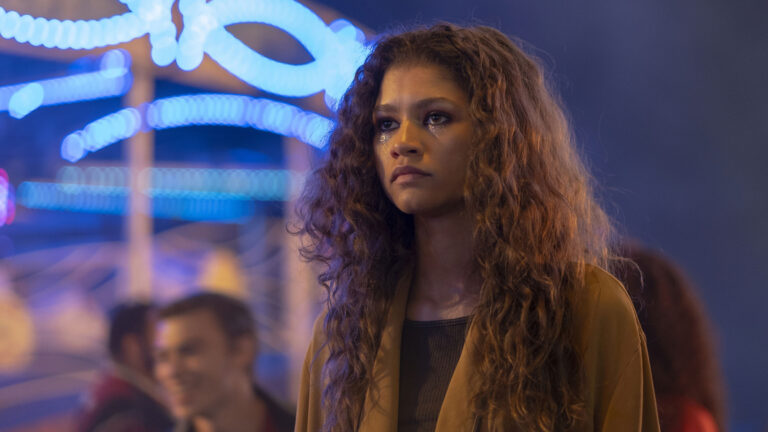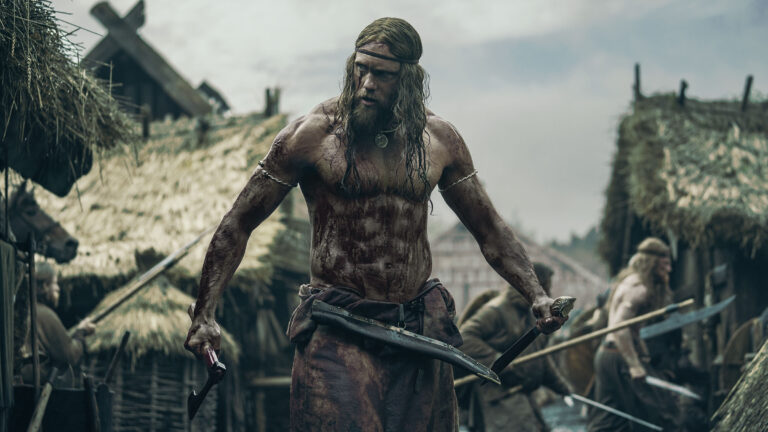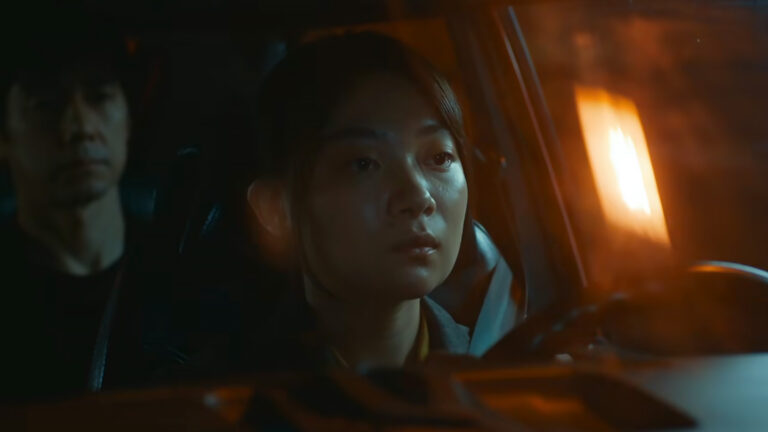I’ve spent more than seven years learning from my colleagues in film, TV, and docs about the art and craft of editing.
My goal is to ask the kinds of questions that you’d ask if you were given the opportunity to sit down with some of the world’s best editors. And I’m very excited to bring this insight and expertise to the Frame.io Insider community.
Today, we’re talking to the ACE Eddie-nominated trio behind Borat Subsequent Moviefilm.
As you might imagine—if you’ve seen the film—the editing challenges were extraordinary. Here to talk about that are Craig Alpert, Michael Giambra, and James Thomas.
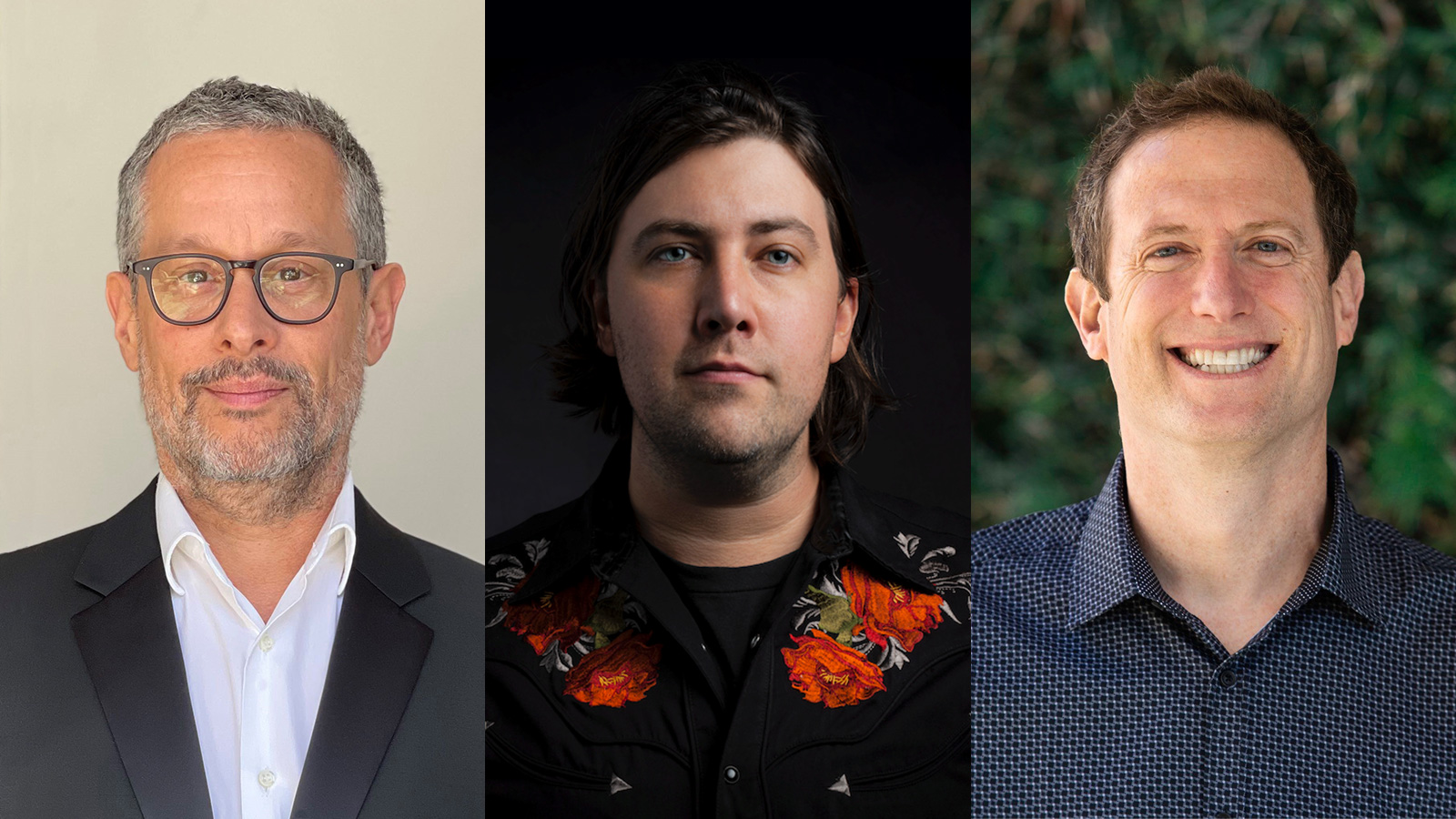
Craig Alpert, ACE, edited Deadpool 2, The Suicide Squad, Knocked Up, Popstar: Never Stop Never Stopping, Talladega Nights, Pineapple Express and the previous Borat movie.
Mike Giambra’s other work includes the TV shows Moonbase 8, Baskets, Decker, and Nathan For You. He also edited the mockumentary Tour de Pharmacy.
James Thomas previously co-edited Pokémon Detective Pikachu, Bad Moms, A Bad Mom’s Christmas, The Brothers Grimsby, and Muppets Most Wanted.
Listen while you read…
HULLFISH: Nice to meet you guys. My first question is about dailies. This film is obviously supposed to seem very much like a documentary. I’m assuming it was shot very much like one. Are dailies handled like a regular film or TV show, or were they much more like a documentary?
GIAMBRA: They were shooting all over the country, so it took a little while for footage to come in.
ALPERT: It’s a combo of both: shot like a documentary but our assistants try to organize it in a way to make it seem like it was shot like a film. There are some pretty organized scenes in the way they were shooting and they knew what they were getting, and then other scenes not. So, it’s a mixture.
THOMAS: What you’re saying, Craig, it was a combo. There was some stuff that was more scripted between Sacha and Maria Bakalova playing Tutar. That stuff was definitely more of a traditional approach in the way the footage was organized, but then the stuff where they go out and shoot with real members of the public, you literally just don’t know what’s going to happen. They’ll drop these flow charts of how they would like the scene to go—the writers have those ideas—but it very rarely goes according to plan.
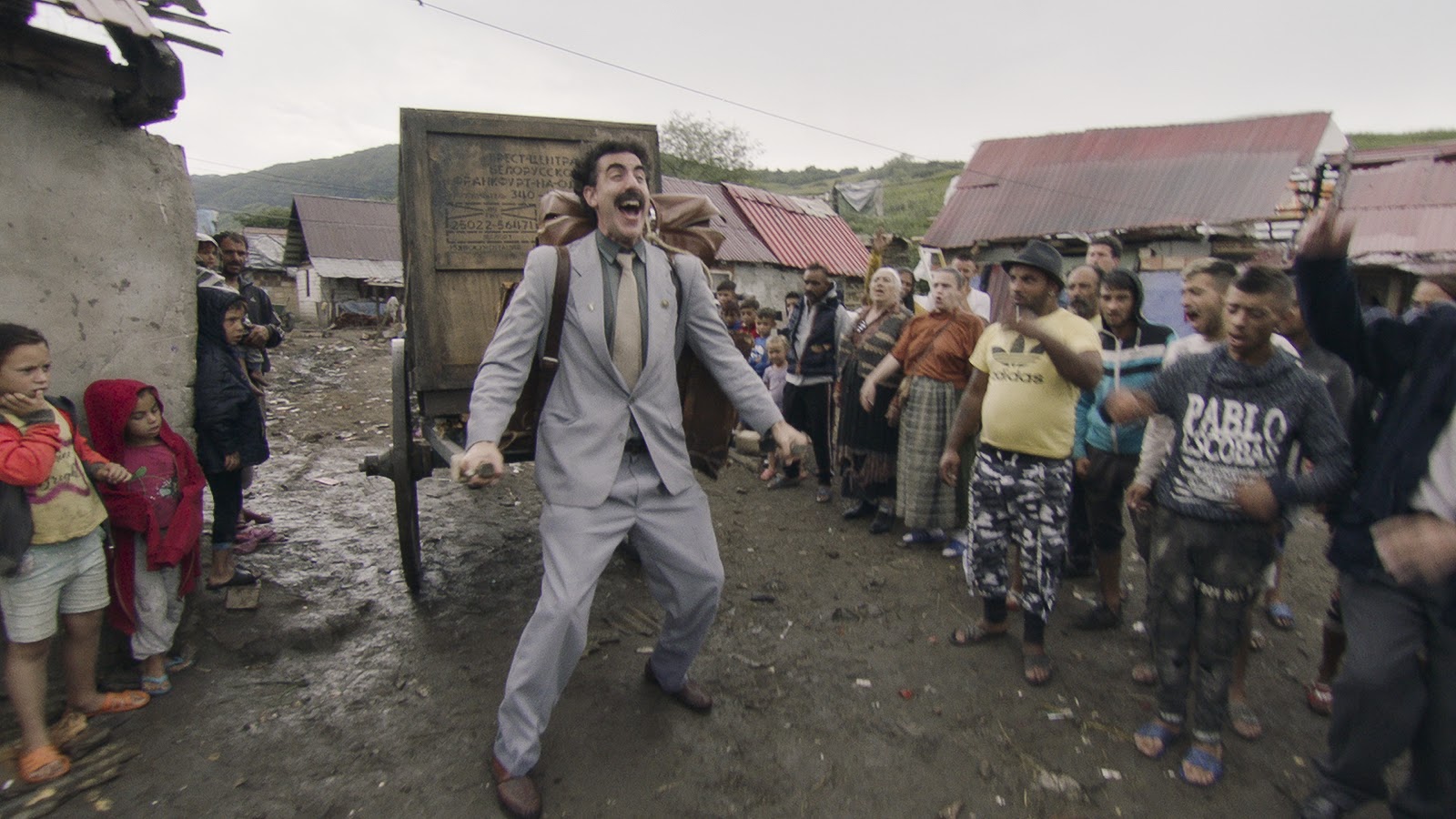
HULLFISH: I was just thinking about coverage and slating because I would think a lot of this—at least the stuff when he goes out and sings at that conservative fair—that couldn’t have been slated. So, how are you navigating that stuff? Are you dealing with it more like a documentary?
ALPERT: Yeah, with a lot of that stuff there’s some things that are shot on an iPhone and then you discover even after you’ve cut the scene that someone shot on an iPhone and they send it to us. The cameras are rolling, they don’t usually stop, and they just pick up a lot of stuff. We organize it the best we can. The assistants do a great job. The rally, I believe, is what you were talking about.
HULLFISH: Yeah, the rally.
THOMAS: The Three Percenters rally that was in Washington state somewhere, I think.
GIAMBRA: That particular scene was like putting together a jigsaw puzzle that’s turned upside down. You have these pieces of footage and some didn’t have audio. Sometimes you just had a three-second clip filmed by some field producer that was maybe sent in two weeks after we put the cut together, and we’re thinking, “Oh, here’s a great reaction. Here’s a great angle on the performance.” So, that scene was constantly evolving because of the chaotic nature of the shoot. They only had one shot to shoot it, so everyone was pulling out their iPhones. We had some hidden cameras going. We had to give a lot of credit to our assistant editors for putting that together because they did their best to try to sync up everything, but we were just looking at the footage in pieces and trying to put it all together.
ALPERT: Some of that stuff we didn’t have audio for. So, I know they had to try to lip-read and write stuff down so we can figure out what was going on.
GIAMBRA: Yeah, we had a bit of a snafu on that day with the audio recording. We lost a couple of hours of footage I think because there was a fault with the recorder. So, we were relying on other sources and ways of syncing stuff up, which definitely put our amazing assistants through the wringer on that one.
HULLFISH: Oh my gosh. And with a scene like that, or even for any of the scenes, how are you watching dailies? Do you like to have them put into a selects reel or are you just looking at things in a bin?
ALPERT: I think you have to watch everything. There’s not really a selects reel for things like this. We’ll hear from Jason Woliner, the director, and Sacha about things from the day that they’d like, but we have to watch it all. I think we all sort of work in different ways anyway. So, I think we all just pull what we like and then everyone just takes a pass at the scene. That was one scene, in particular, that was being re-cut until the last minute.
We have to be able to say to him, emphatically, we’ve seen everything and that’s it. That’s the best stuff.
HULLFISH: I used the wrong term, perhaps. I was thinking more like a KEM roll where some editors just put everything into a sequence that’s been shot for the day or for the scene so they can watch it in one four-hour go.
THOMAS: That’s what we do. Basically a KEM roll, exactly that. A string out goes into the top of the bin, and then, as Craig said, we all have a different process, but my process is that I go through and I watch everything and I put locators on that. Then I try and add those locators, so when you sort it, all the same ideas appear in one spot and then you start cutting. With this material, you can’t afford to not watch it all cause there will inevitably be a gem buried somewhere. Something that I know for a fact keeps Sacha up at night is that there’s this amazing line or moment or look somewhere lingering in the dailies. We have to be able to say to him, emphatically, we’ve seen everything and that’s it. That’s the best stuff.
GIAMBRA: There was one particular shot in that rally with the guy that’s giving the sieg heil salute, and someone said that they shot it. I hadn’t seen it cause there were maybe 200 or 300 individual video files from that scene, maybe five hours total of footage, and it’s hard to really remember everything you saw and some things slipped through the cracks. Fortunately, we had an ace AE team that was able to find it. So, it’s hard to really keep track of it all, but it’s good to have multiple editors because we can all make sure that we’ve seen everything.
HULLFISH: How did you guys collaborate? It doesn’t sound like you took separate scenes necessarily.
THOMAS: No, it was definitely a collaboration. That’s what’s so great about this is that one of us would initially assemble a scene and then as the movie came together, we started sharing stuff. All three of us had a crack at pretty much every scene in the movie, I would say, at some point.
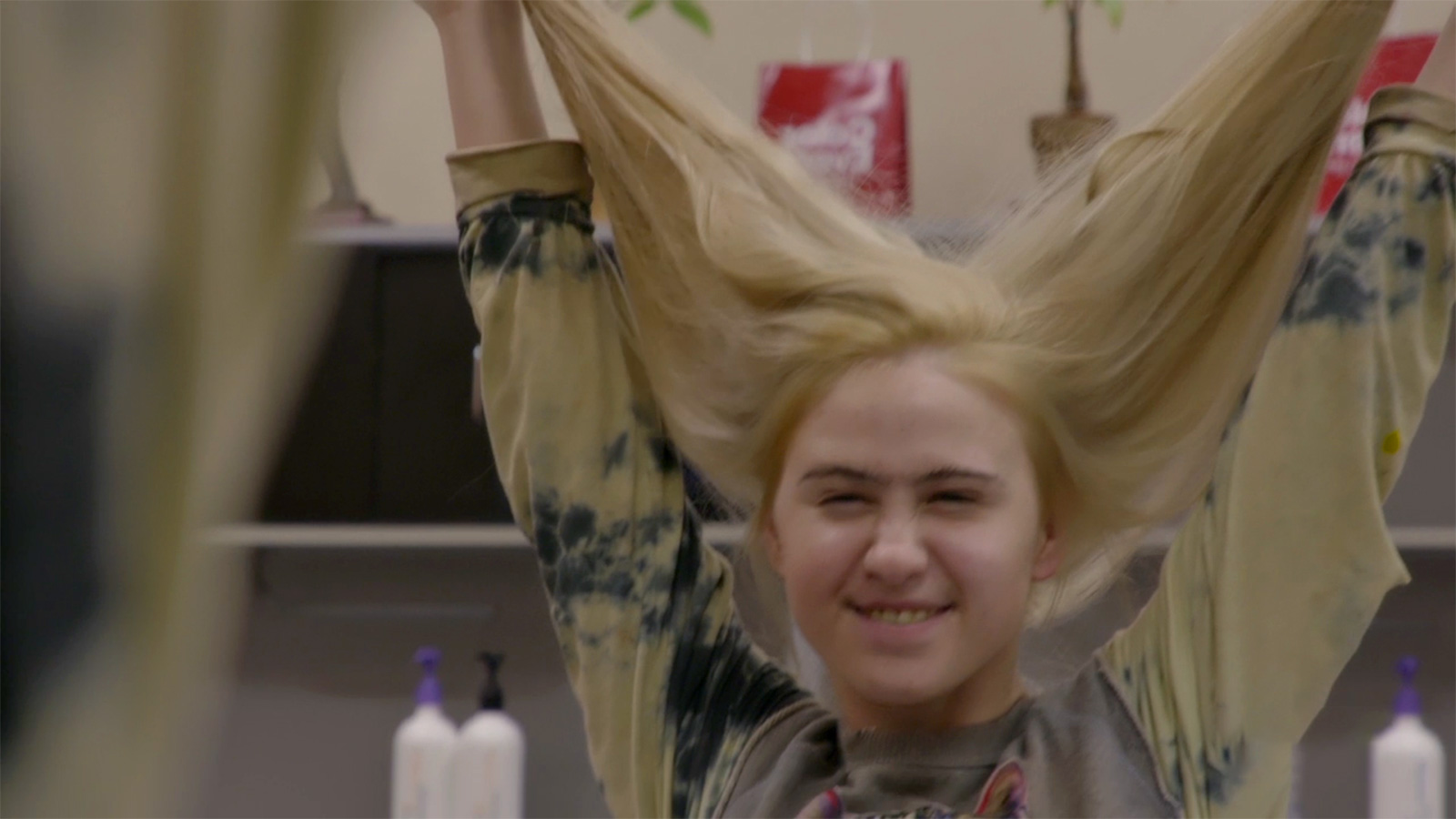
ALPERT: Yeah, I thought it was pretty amazing cause I think that’s rare that a group of editors can just go in and have their hands in every scene. James will get something, Michael will get something, I will get something… and we’ll all go in and keep making passes and then it will just go on to someone else. It’s the type of collaboration where it really worked. It was great.
GIAMBRA: It allowed Sacha and Jason to look at all of our separate cuts and say, “I really love the way James set up this. I love this reaction that Craig found here.” It allowed him to really put together a mishmash of a cut based on everything that we think is best for the scene, because I would watch these scenes and think, “Oh, they did a great job. It’s the best yet.” But still Sacha is always pushing us to try new things, find more, and discover more from the scene, and present more options that he can choose from.
HULLFISH: Two of you worked on the previous film, Craig and James, correct? Obviously, on this film you know what you’re in for, but what was that first Borat movie like?
American audiences were like, ‘What the hell?’ in the best possible way.
THOMAS: It was a great experience all around. It was amazing. We were under the radar. No one really knew what was going on, but it’s important to say: Sacha had been doing that character for at least three or four years, maybe even more like five years, prior to that. There was a show called The 11 O’clock Show, which I met him on in London, and they were developing the Borat character then. We did a couple of specials for Channel 4 with the character. In fact, the opening to the first movie is very similar to something that we did for a TV show maybe three or four years prior. So, it felt like a continuation, but it was definitely a shock to American audiences. American audiences were like, “What the hell?” in the best possible way.
ALPERT: It was pretty fresh for me because I had never worked on anything like that and I was just transitioning out of being an assistant editor. So, I think that was maybe the second time I’d actually been hired as an editor. Everything about it just seemed new.
THOMAS: It was crazy, wasn’t it?
ALPERT: Yeah, it was. I think back, it was crazy.
HULLFISH: I’m always interested in the personalities of editors and how you would deal with the material as you’re looking at dailies, or rushes. Tell me about your reactions to those as a viewer and does that make it more interesting or more uncomfortable?
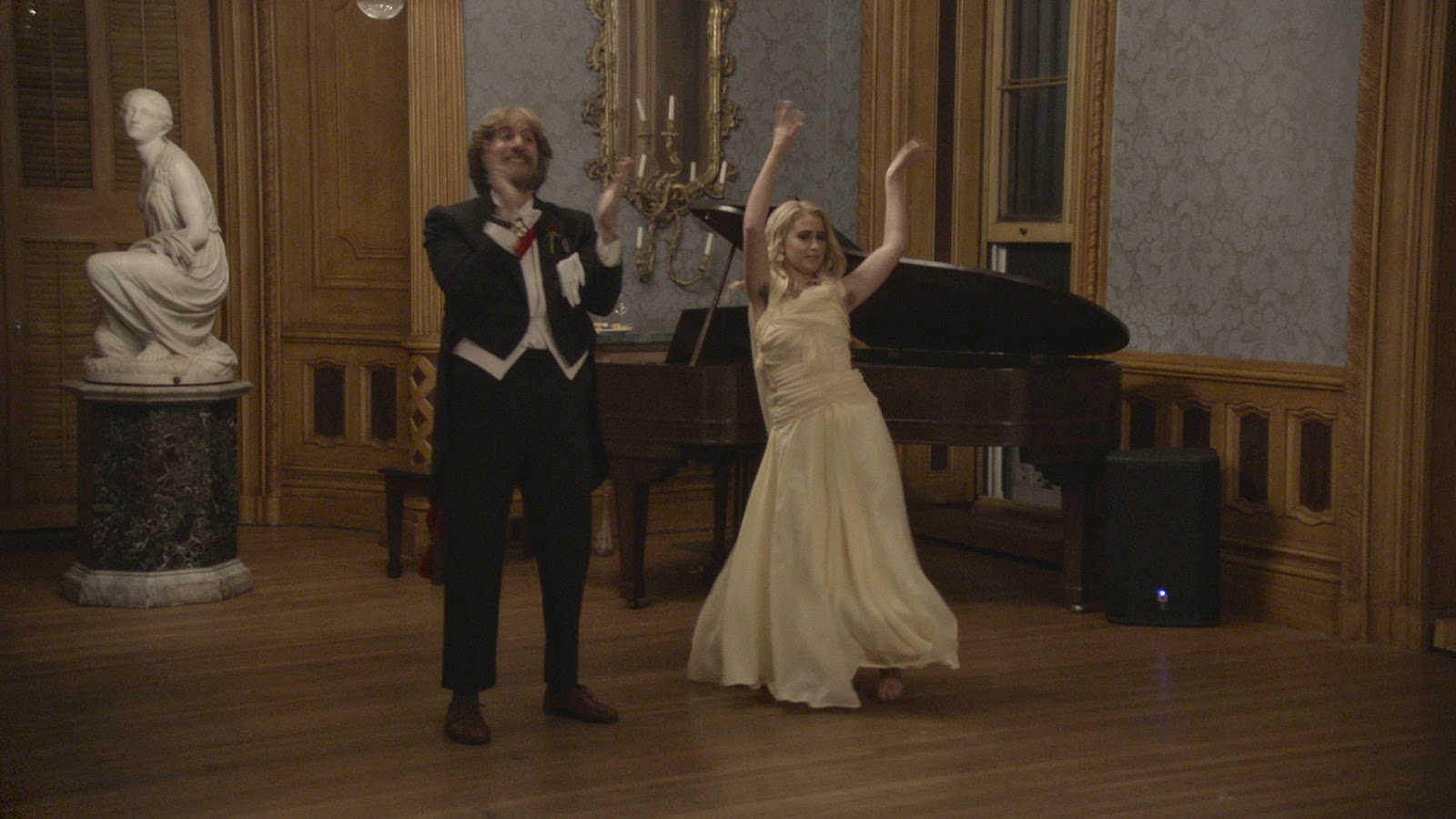
THOMAS: Yeah, it was an interesting exercise, that first movie, because I think I was hired initially not to cut. They had a couple of other editors on and I was really hired to watch material and just let Sacha know what I thought was funny. But then I started cutting and everyone started enjoying that stuff, and so I then became one of the editors on the show. This sounds crazy but I think for the first six months working on the show I literally didn’t make a cut. In those days I used to have big notebooks and I would just sit and write notes about scenes. I did that literally for six months and then started cutting after that. So, there was some crazy stuff in there that never made it into the movie. There was some stuff with Pamela Anderson getting married on a beach to Kelly Slater that never, ever made it into the movie, and Borat appeared with a key card. Can you remember that, Craig?
ALPERT: Yeah, wearing his green beanie.
HULLFISH: That’s hysterical. Let’s talk about some of the stuff that didn’t make it in, because I’m sure that there were some babies that had to be killed that you guys loved that were very funny, and yet didn’t go with the flow or didn’t go with the story. Can you share anything that would have gone in your notebook but couldn’t go in the film?
ALPERT: I think in every movie there’s always stuff that doesn’t make it in, especially this movie in particular because when COVID hit it had to be re-conceived a little bit and the story was rewritten. So, a lot of stuff just didn’t make it, but everything that I think belongs in the movie is in.
GIAMBRA: Yeah, watching the movie I thought, “There’s nothing I particularly miss.” There are great moments that were really funny, but Sacha is brutal. He wants to chop it as bare as we can, saying, “Let’s just hit the big jokes. Let’s lose all the mid-level jokes and just let this hit hard.” So, he was really focusing on the best jokes. There were opportunities during the process where we could introduce a new joke, and if they bombed or didn’t do great, then they just disappeared and I fell out of love with them. I’m pretty happy with what’s in there now.
HULLFISH: I’m sure that everything that belongs in the movie got in the movie, and everything that didn’t isn’t, but I know that there’s people that I’ve talked to who said, “We had to lose one of the funniest scenes.” I’ve done that myself for a film. I cut a scene that went together and it was a great scene, but when you put them all together, you think, “This great scene does not belong in the movie.”
GIAMBRA: I guess there was a golf scene when he’s learning to play golf, and it’s just straight out of Three Stooges. It’s amazing. It might see the light of day at some point, but it was a scene that had no connection to the story at all. I think it was maybe part of an earlier draft of the script and it was one of the first scenes that was cut. It was hilarious, and we tried to keep it in so many times almost until the end. There’s a scene where Borat becomes a barber to make money, so we tried to weave that in like maybe he’s trying to learn how to play golf or become a golf instructor, and it just seemed a little too out there.
There are great moments that were really funny, but Sacha is brutal. He wants to chop it as bare as we can.
THOMAS: It never worked. It just seemed a bit contrived, trying to get it in right until the last moment. It was classic Sacha stuff. It was a very, almost mime sequence with him playing golf and running off to get the golf balls and driving the golf pro nuts. I’m sure it will see the light of day and hopefully it’ll show up somewhere because it was really funny.
HULLFISH: You guys mentioned COVID. Can you give me a little bit of the timeline of when COVID hit in the production of the movie, and then how did you collaborate?
THOMAS: I think we had been on the show since around September, October of 2019, then COVID hit in March of 2020. The initial reaction was we need to shut down and stop filming. The decision was that so much material had been shot previously that we should keep going. So, we kept going and in that period was when we discovered a moment in the dailies that then changed the course of the rest of the movie, which was basically when they went to CPAC. There was the speech that Pence gives at the podium where he’s talking about how prepared the Trump administration is, saying, “As of now there’s only 15 cases of COVID-19, and I was talking to the president yesterday and we’re ready for anything.” There was just this moment where we found this clip and we shared it amongst ourselves and with Jason and Sacha and we said, “Well, we now have to embrace COVID, right? That has to become a central part of the movie.”
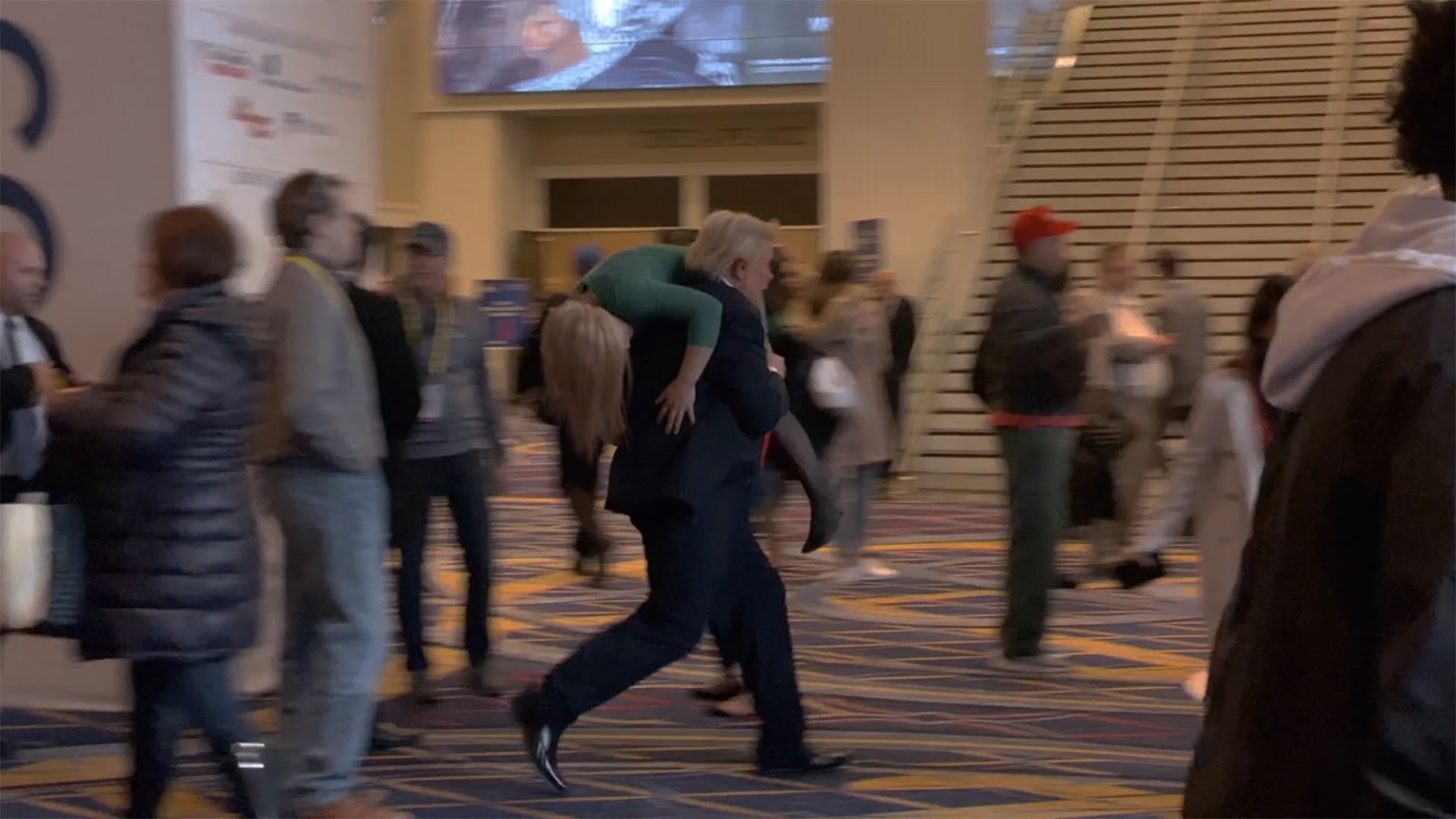
Originally, CPAC was destined to be the culmination of act three. It was supposed to be the end of the film, the big payoff. So, the movie was then pretty substantially re-imagined and restructured based around pulling that up into the second act. It did have a pretty profound effect on the rest of the film. Obviously, Giuliani then came and filled the gap at the end of the movie, so it was a win-win situation. It worked out for us.
HULLFISH: Tell me about how that worked. There were scriptwriters working all this time, right? How did that decision to rearrange the film come about? Between the three of you guys, or with the director and Sacha? How did that happen?
THOMAS: It was the whole group. Jason, our director, Sacha, and Anthony Hines, one of the lead writers, they saw the potential for that moment to inform the rest of the movie and then they adjusted everything that followed afterwards. So, that’s why we had such a hectic schedule because that happened in April of last year and we had this deadline of the election. Our delivery was October 23rd I think. We basically re-imagined the movie in those months between April and October, and it was pretty hectic, to put it mildly.
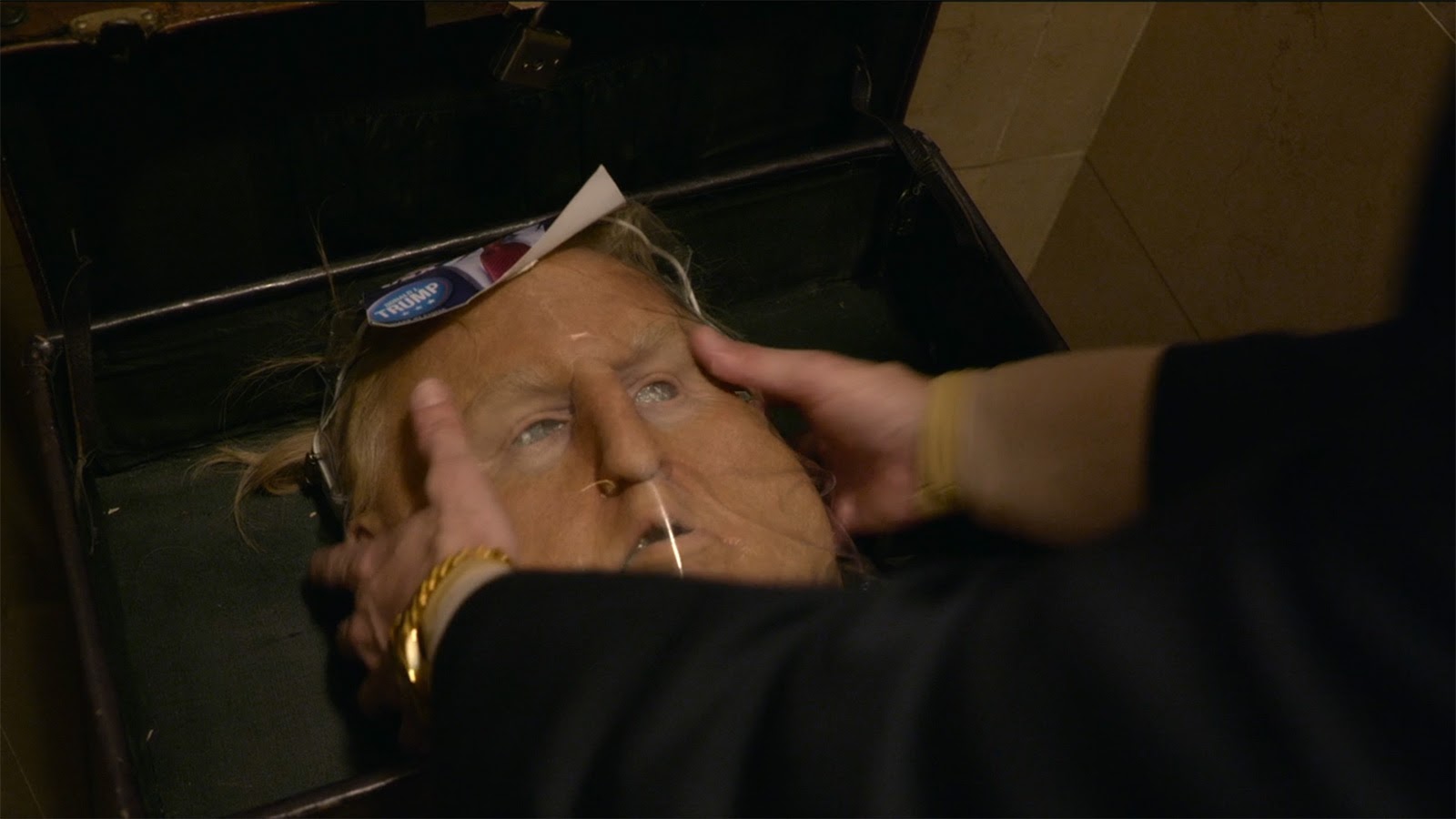
ALPERT: It wasn’t all decided right away. It just developed as a whole all the way up until we had to stop. We were all working from home, and I was really surprised by how well it went. We shut down and then two days later we walked home with hard drives and just plugged in, started working, met on zoom every day, and talked throughout the day. We used Evercast and it really was a fairly smooth process for a film this crazy to not be together in an office.
HULLFISH: You used Evercast and local hard drives?
ALPERT: That was the fastest way to get us working because I think the assistants already had some backups of the media and just made more. We worked like that maybe for six weeks, and then we shut down. Then, when we came back up is when we did not work local and then we used Jump, the remote desktop program we used to connect, which is great. We all connected to storage and AVIDs that were at a facility.
HULLFISH: So Jump and Evercast?
ALPERT: Yeah, Evercast we were using with Sacha and Jason to show cuts and communicate.
HULLFISH: Do you have any further thoughts about working from home? Were you even in different cities?
THOMAS: No, we were all in and around Los Angeles, but I think as editors we’ve all fantasized about that, right? We’ve all thought, “I could be in a hammock in The Bahamas.” It never quite works out like that, but I’m sitting at home and we’re all sitting at home. As Craig says, it works surprisingly well. It’s constantly changing and I know Jump is doing a lot of work behind the scenes all the time to improve the interface. I’m on another movie now that’s shooting in London and a huge amount of material is being shot every day, seven to eight hours a day of material, and knock on wood, it’s working. It works really well.
HULLFISH: That’s great. Between the three of you collaborating, is that also Evercast? Or is that more like just sharing cuts? Was there a lot of conversation?
ALPERT: We’re all talking throughout the day, either through FaceTime or text. Either, we’d check out the cut we did in the bin, or I think sometimes we logged on to go through stuff together. I think normally, we would just go into the cuts with the reels bins and just look at what everyone else was doing. Communication is important when you’re separated like that.
GIAMBRA: Yeah, there were times where I felt like we were spending so much time on zoom, phone calls, texts, and Evercast that we didn’t have much time to cut, but thinking about it, if we were all in the same office we would be popping into each other’s offices and yelling across the hall and everything. So, I think it was valuable in order to keep the film on track for our October release date that we had to stay on top of it every day.
People are very savvy now when they watch movies. They can tell when stuff has been edited.
HULLFISH: Is there a trick to cutting something that’s heavily improvised? I know there were very scripted scenes, but obviously a lot of it’s improvised or ad-libbed. What does that do to either organization or your ability to cut with continuity?
THOMAS: Again, it’s not really like a conventional movie because, in the instance of a scene like Rudy Giuliani, you get one opportunity. It’s all about the preparation that Jason, Luke, our DOP, Sacha, and everyone puts into preparing for that scene, and then it’s a one-shot scenario. So, they have to make sure they’ve got all the cameras in the right place.
Sacha has this rule of thumb that he has developed over the years, which is that a two-shot—a wide-ish two-shot—is the holy grail of what he does. Because people are very savvy now when they watch movies. They can tell when stuff has been edited. Obviously, a lot of what Sacha is doing in the moment can be contained within that two-shot, and so we as editors tend to favor that. That is the bedrock of what we’re doing. We tend not to vary too much from that if we can. Some scenes are more complicated. There’s more coverage for CPAC or the rally that we were talking about earlier because everyone’s got a camera and three weeks into having thought we were in good shape on a scene one of the field producers will say, “What about that material that I shot on my iPhone?” And we say, “Send it on over. We’ll take a look at it.”
HULLFISH: I interviewed Steve Rotter who cut Dirty Rotten Scoundrels and a bunch of other comedies, and one of the things that we talked about was that old-time comedy thing of being on a two-shot. That’s the holy grail where the characters are big enough to be seen—you can see expressions—but you know that they’re interacting with each other in real space.
ALPERT: Yes. There’s something very credible about that, right? You’re not trying to control the rhythm of the comedy by cutting to a closeup for a reaction. Or if they’re shocked, Sacha always wants to see them so they’re slightly faced out towards the camera and then you can see the reactions and the nuances of what’s going on. Yeah, that’s definitely something that we use as our approach.
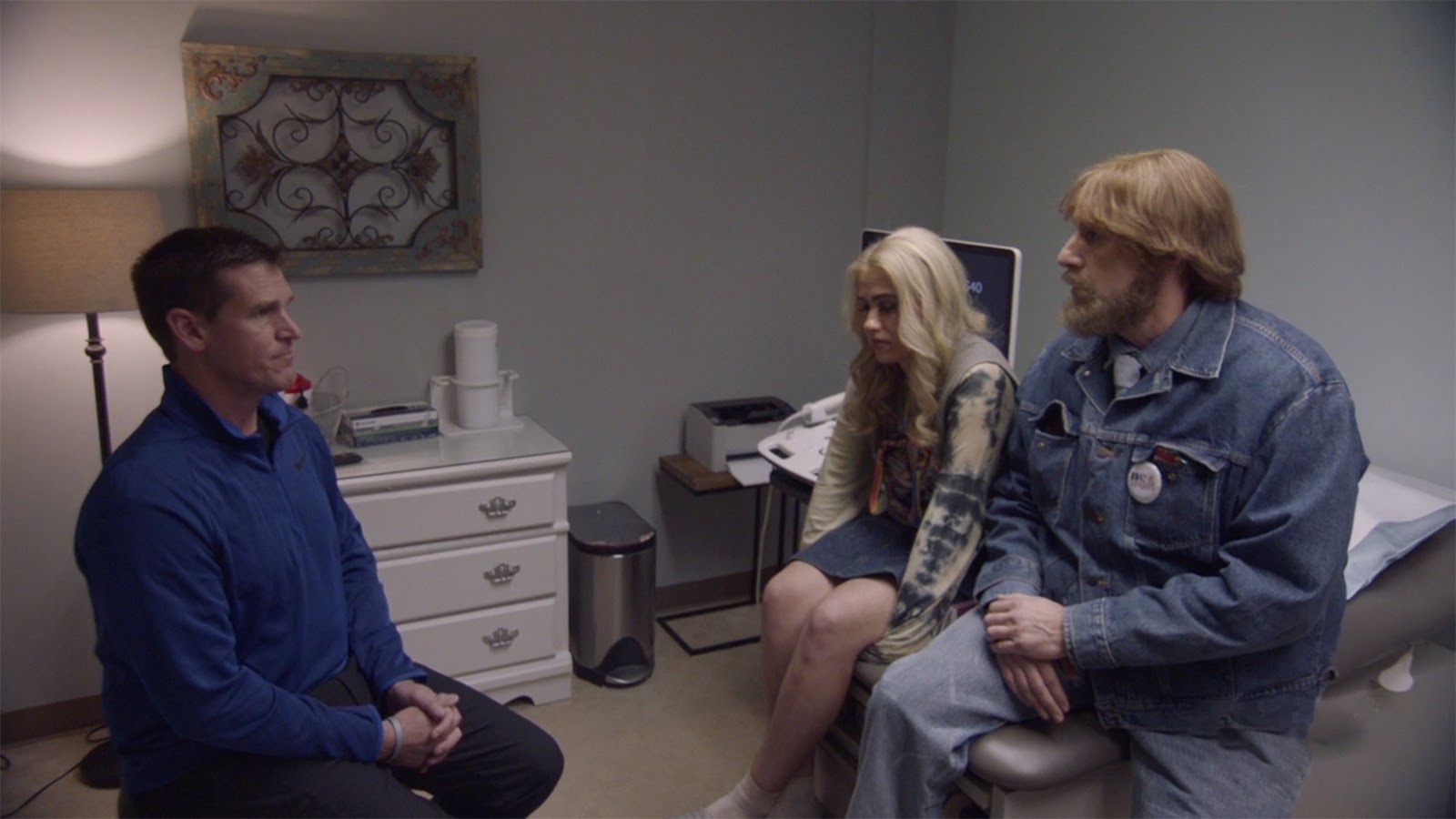
HULLFISH: What about transitions of scenes? Obviously, there’s a flow to the movie. You feel like you’re being told a story that you’re going from one to the other, but then there are things, like you said, where he’s trying to make money being a barber. Is there a trick to the transitions? Did you feel like there was some way to make that flow the way that it did?
THOMAS: The COVID lockdown happened and the crew had to consider what else they needed to shoot. They looked at the movie—at every scene that we had—and said, “We need to shoot as little as possible to finish this movie.” Then, they shot a lot of those scenes between Tutar and Borat. Once those came in, it helped pace out the movie so it didn’t feel like a collection of random scenes with real people. So, you can have a really big comedic scene and then a nice little story scene with Tutar and Borat. It was just a matter of figuring out the balance between those two things, and it really helped to figure out the pacing and making sure we had all the story points that we wanted to hit in the film.
HULLFISH: I want to explore that idea of COVID shutting things down and then you guys—whether it’s you, the producers, Sacha—putting stuff in context and re-evaluating, “What are we missing and what needs to get shot?” What are those conversations like?
THOMAS: This whole process is like every movie that he’s done, and every movie that a lot of comedy people do in Hollywood: it’s driven by showing it to an audience. So, something that is inherent to making these films are his previews. Obviously, because of COVID, that was all fairly restricted. One of our producers, I think maybe Monica Levinson, came up with the idea of testing out of the country and testing in New Zealand because they had done a great job with COVID.
HULLFISH: Yeah, zero cases.
THOMAS: Zero cases, and we had some contacts in New Zealand. Through them, we arranged to basically screen the movie in Wellington to a normal audience. So, a theater with 250 folks in it, and we do the usual thing: record them and get them to fill in questionnaires. They are an integral part of that process. What’s not working, what is working, what do we need to patch here. So, that was what really got us on the road for finishing the movie or allowing us to finish the movie pretty quickly.
HULLFISH: Did that audience in Wellington see the film without some scenes with Tutar and Borat or whatever got shot post-COVID?
ALPERT: When we started screening over there, I think we pretty much had everything. We might not have had the first time when Borat was recognized on the street, which is about 15 minutes in.
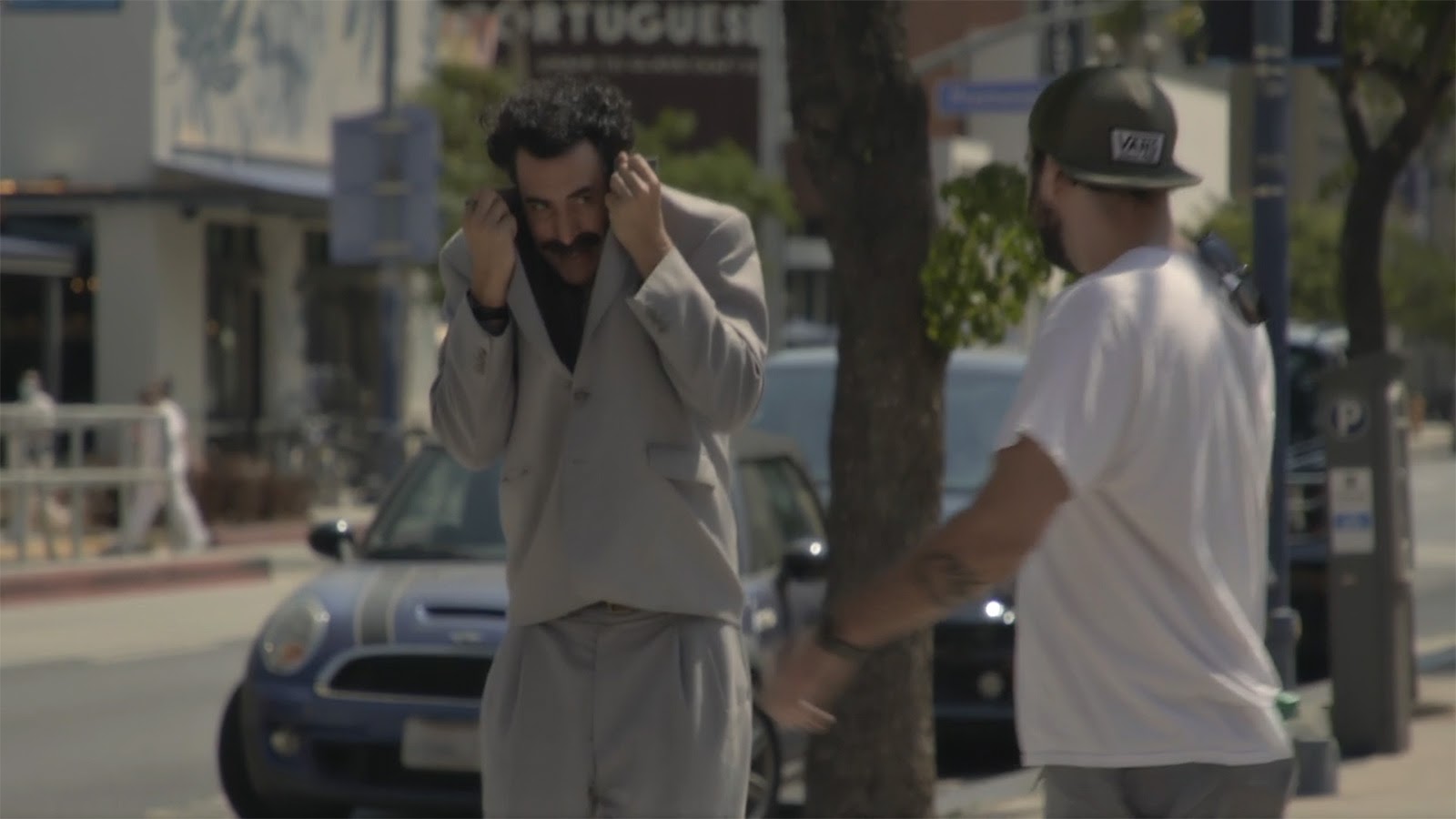
GIAMBRA: We had a version of it, but they wanted to reshoot it. So, we had something that worked to satisfy the story, but it wasn’t hitting comedically so they wanted to reshoot that.
ALPERT: Yeah.
THOMAS: We never really showed the movie in an incomplete form. We never showed a version with boards or anything in it.
GIAMBRA: Just to friends and family, which is odd to think about because the friends and family screening was the day before we were sent home with our hard drives. I was thinking, “Should we be shaking hands here? Should we be hugging?” People came out and watched the movie and it was enormously helpful because we knew what we had to do once we were able to go home with the hard drives. We had data. We had a lot of emails that people were sending in saying, “Oh, this was great. Maybe you could fix this. Finesse this.” So, we had that guidance, which was great.
HULLFISH: I’m assuming none of you guys were there for that screening that was done in Wellington.
THOMAS: No, we just Zoomed in. We had a production company, basically, on the ground there, and they set it up in a really great way where we were able to zoom in, watch the movie, see the audience reaction, and then listen to the focus group afterwards. We had multiple screenings there, I would say four or five.
ALPERT: They had microphones going up the side too, which we usually do to record audience screenings for comedies anyway, but they fed it all into a laptop, so you’d hear more of the audience and less of the screen. I thought it was very well done.
HULLFISH: You guys have done these screenings with these comedies before, did you lose something by not being there to feel the butts wiggling in the seats and the coughing of the audience? I guess you’re hearing all that stuff, but did it feel different?
You’re figuring out some pacing things based around the response, which is a double-edged sword.
ALPERT: I thought it was okay, honestly. We had night vision cameras on them too so you can watch. In other movies, after preview nights, I come in the next day and I listen to the laugh-recorded track. I don’t usually use the night vision video, but I listen to it just cause I can really focus more on how it played it rather than in the theater being surrounded by people. So, to me, it worked out just fine.
HULLFISH: Do you guys sync that recording with the movie?
ALPERT: Yeah, the assistants sync it up.
THOMAS: It’s a very useful tool. Sometimes actually we’ll even cut with it. You’re figuring out some pacing things based around the response, which is a double-edged sword. You can end up with some pregnant pauses in the movie if you’re sitting at home watching it, but I do like being in an audience because it’s fun. If the movie’s playing well, then it’s this amazing experience. On the first Borat movie, we did a couple of previews just for the hell of it because we were all having such a good time. Sacha changed a line of ADR and we were saying, “Let’s preview the movie again! It’ll be great,” and it was. It was really fun.
HULLFISH: Yeah, you can definitely do that where you sync it up, you listen, and think, “Oh my gosh, this applause is lasting. We don’t want to lose this joke that comes immediately after,” and so you open it up a little bit, right?
THOMAS: Exactly. Sacha is all over that, to put it mildly. He wants to make sure that you’re not stepping on the enjoyment of a particular joke.
HULLFISH: Yeah, that’s a fine line because every audience reacts differently. As you said, if you watch it at home then there’s nobody else to laugh, except for maybe you or your wife or your buddy. Talk to me about using that and determining how big a laugh is and how long to let a laugh go in a comedy?
THOMAS: Sacha has this system he’s developed with Lisa Rudin, and he’s used it right from the TV days, for rating jokes. So, we’ll start with a quarter, a half, three quarters, a full laugh which is a star, a two-star, and a three-star. The final objective with the movies, I’m not kidding, is to have nothing below a three quarters in the film, and I think we probably have achieved that on both the Borats. We’ll show up in the morning after preview and there’ll be a tone by the time we’ve got to preview 12 or whatever. There’ll be all the laugh data for every single screening for every joke in the movie scored. That will be waiting for us on the desk. All of that information is collated into giving each joke a percentage. It’s not scientific, but it’s approached sometimes like it is. If the number goes down, then the question is: what happened to the scene? There’s so many different answers, right? Because the context may have changed. It may fall in a different place. The audience may be cold. They didn’t have enough pizza. They weren’t drunk enough. Whatever it is, there’s going to be all of these different permutations, but it’s a way of quantifying stuff. He likes to work like that.
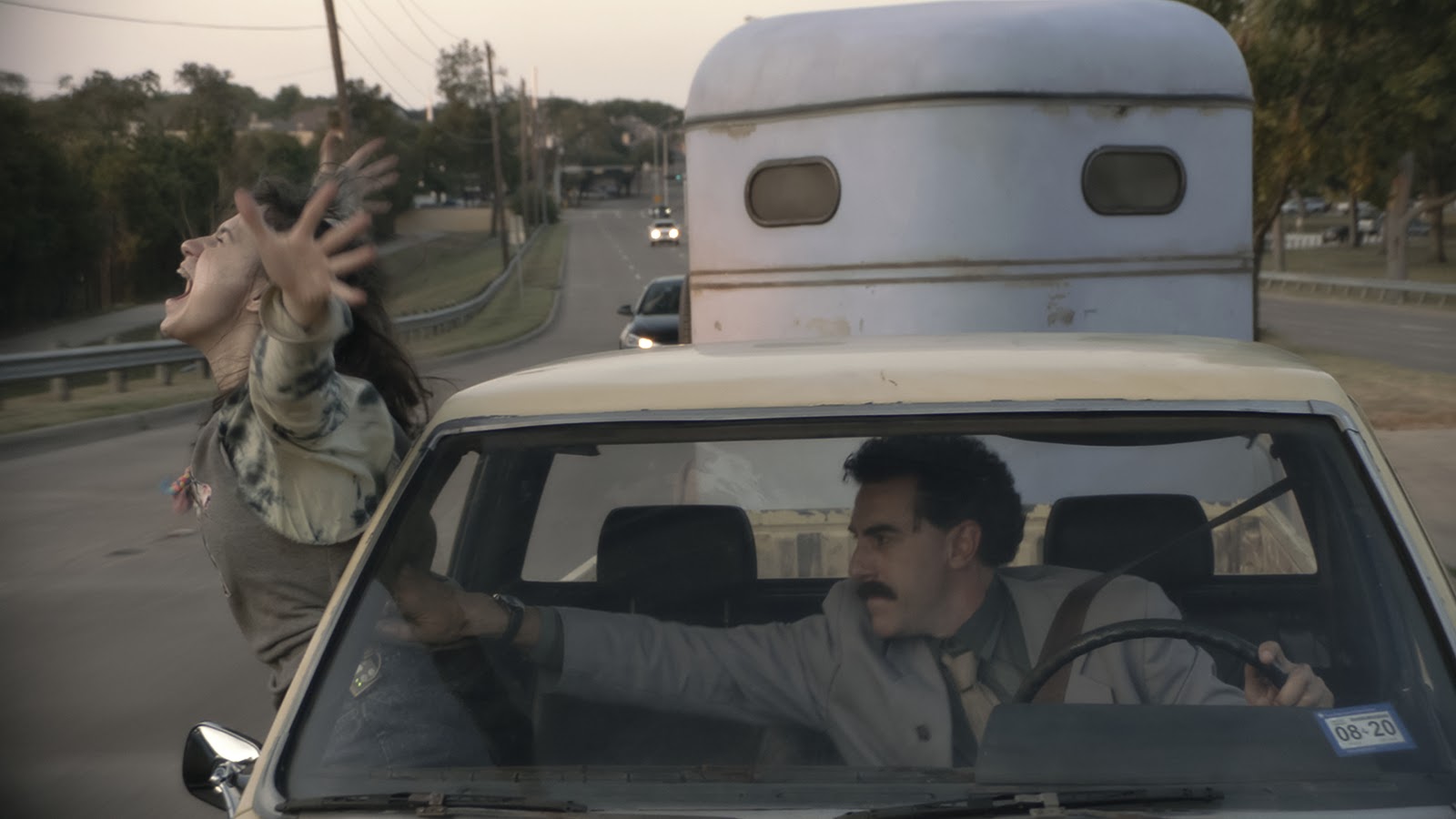
HULLFISH: So, the rating system is not how funny Sacha or Lisa thinks it is, it’s how funny she thinks the audience thinks it is?
THOMAS: Correct, yes.
ALPERT: You still compare the number to the actual laugh because I always like to hear it myself too. So, it’s nice to just back it up by listening to the audience record, but it’s pretty easy just to look at paper and just say, “This joke played better two screenings ago than this. What did we change leading up to it or surrounding it that affected it?” So, it’s an interesting tool.
HULLFISH: The joke doesn’t have to be the words that are spoken, right? It can be your edit, timing, or setup?
ALPERT: Of course.
GIAMBRA: Yeah, if you’re moving the set up of the joke and you don’t know who these people are, you don’t really understand the stakes of the situation and it affects the joke and the humor. It’s surprising just to how a little lift or edit can just totally change the impact of the joke.
HULLFISH: There’s a funny little line and then there’s something that builds on that and something that builds on that. I would think of Borat at giving the haircut scene, right? It kept getting funnier and more outrageous as it went.
GIAMBRA: Yeah, that was interesting. My initial cut was eight minutes long, and I got emails from Jason and Sacha and one of the writers that they’re just crying by the end of it because it just built up on this insanity of: why is this guy giving him a haircut? He’s ill fit for this job. But then you play it to an audience and it might play a little differently because you have a really tight one minute scene and, then it goes into an eight minute barber scene that really doesn’t need to be eight minutes. Then, as an audience, you’re wondering, “What am I supposed to be getting out of this?” So, we did our best to cut it down and consulted the laugh tracks, consulted the data to really just focus on the best and biggest moments from that scene. We all have to really consider the pacing of scenes previous or the jokes before when we’re shaping these scenes.
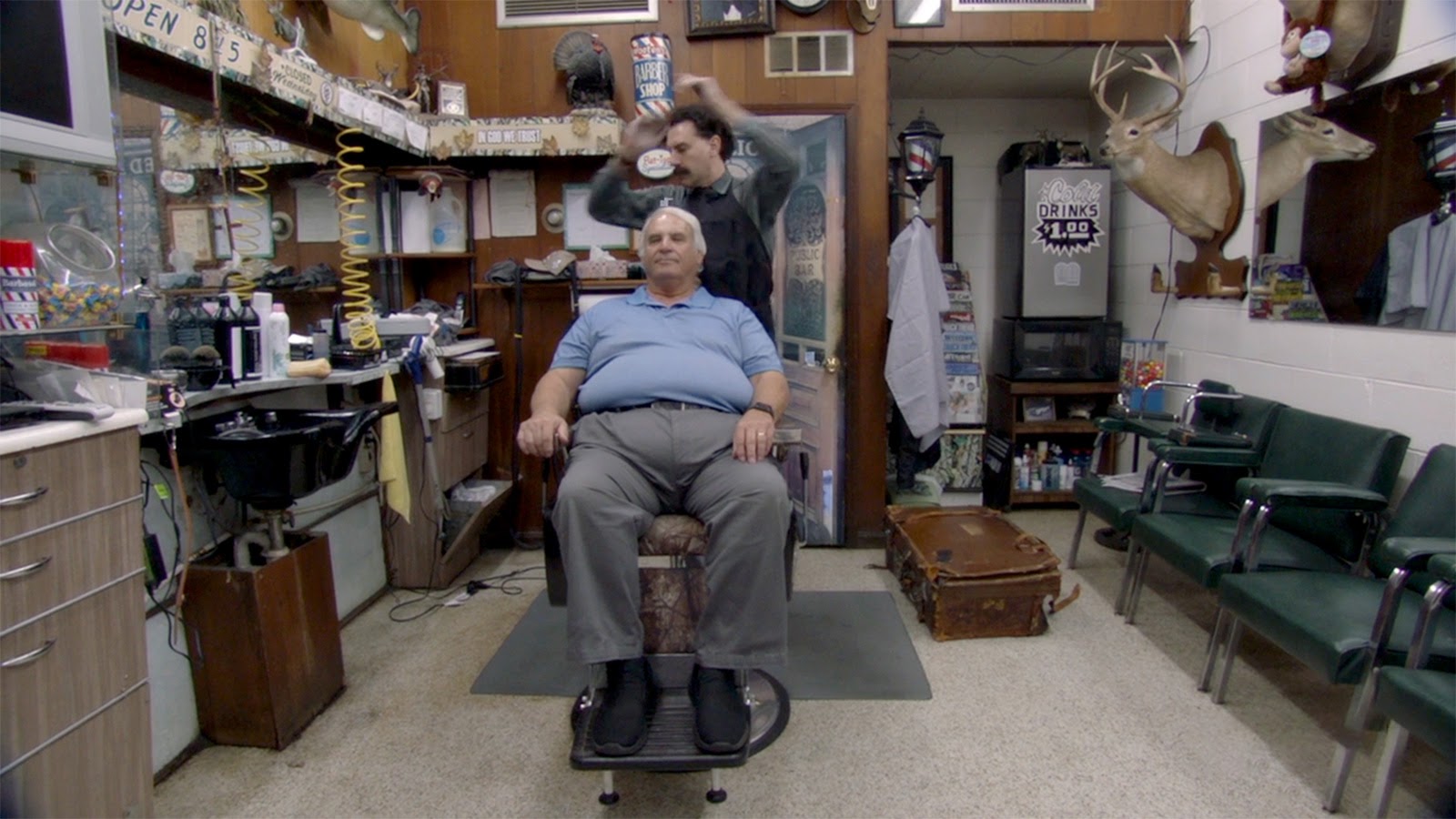
HULLFISH: Music-wise or sound-wise did you temp with anything?
THOMAS: We did temp. The philosophy, and there is a philosophy with this stuff, is that we want it to sound real. We want it to sound like a documentary. So, all of the conventional audio tropes that we’re all used to with movies, such as foley, all of that kind of stuff doesn’t really feature in these films because it’s a level of polish that can be a little bit distracting, and these movies are real. So, we’re just leaning into that by not augmenting stuff, particularly foley. That’s one of the things that we stay away from in terms of sound.
HULLFISH: Did you go back to those Channel 4 shows and watch the old Borat? Or Craig, when you first joined the team on the original, did you think, “I’ve got to watch and see who this guy is”?
ALPERT: Yeah, because I think at that point, it had already been running on HBO. I had seen whatever was on HBO, but not anything from the 11 O’clock Show.
THOMAS: Honestly, Borat really kicked in with the HBO show doing him every week. Whereas, on the 11 O’clock Show, there were only a couple of Borat things that we did.
ALPERT: I was a huge fan and just didn’t really know what to expect when coming on. I think even as we were cutting the film, until we had a real audience preview, I don’t think we understood what we had. Then, the audience freaked out in the best way ever. I still refer to that on every movie. You just can’t explain the level of enthusiasm that was in that theater and how loud they were, so loud that you couldn’t even hear what was coming off the screen at some parts. It was absolutely insane.
THOMAS: They broke a row of chairs. Can you remember the row of cinema seats that are bolted into the floor? We were in that fairly old AMC down in Marina Del Ray, which we favored because it was flat—it wasn’t raised seating, which destroys laughter with a comedy—and literally, a whole row of seats just came off the floor. People were rocking around so much.
ALPERT: I think it was during the naked fight that I remember people standing up.
THOMAS: It was so much fun. It was like being at a rock concert or something. It was amazing.
HULLFISH: I love comedies, but I got to say, when I was watching this, that debutante scene where they’re dancing… I was literally screaming at the TV.
THOMAS: Yeah, that’s a crazy scene, and that’s such a Sacha scene, right? It’s like you get an idea and you push it, and then you push it till it falls off the cliff, and then you run after it down the cliff and throw it down. It was full commitment. Maria too, she had some courage to go into that situation and do that fertility dance.
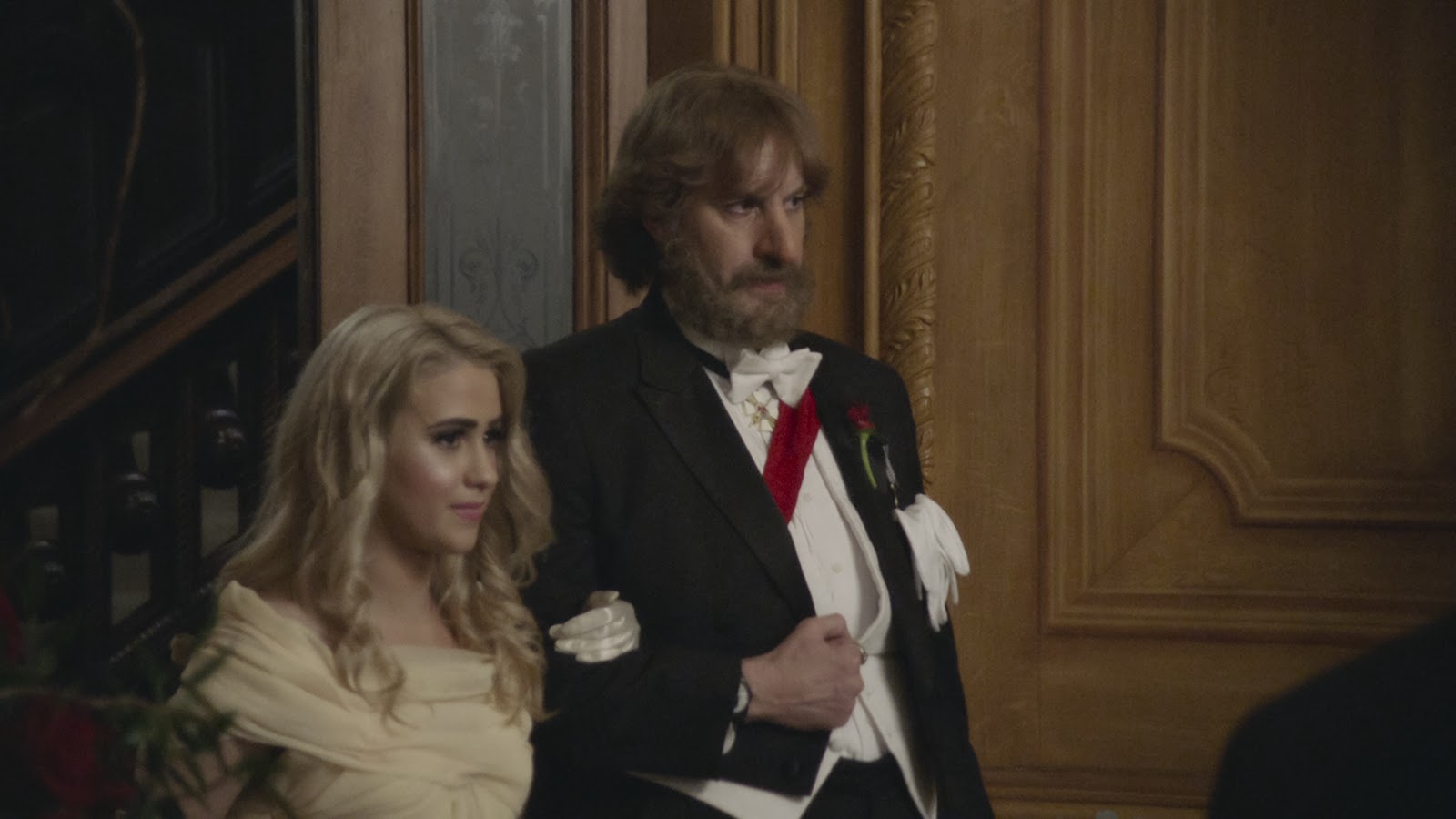
HULLFISH: With that debutante scene, those people had to know they were being filmed because there were cameras and people were talking to them, but they didn’t know that they were being pranked?
THOMAS: So, the field department does incredible work to set all these things up. It does involve a certain amount of subterfuge, and I’m not sure what they were particularly told in Macron, Georgia. Probably something to do with a journalist from out of town with his daughter investigating American traditions. That’s normally how they would set it up: “Could she come and be presented as a debutante because he’s doing research for his Kazakh TV show?” That’s normally how it goes. I don’t know if this was any different. Mike, was that one set up differently?
GIAMBRA: No, I think they’re setting it up as two people from somewhere in the Middle East and they were wanting to explore the Southern tradition of the debutante ball. So, everyone was really trying to bring them into their world, so it was quite shocking once they saw what they saw during the dance.
HULLFISH: Talk to me about dealing with notes—getting notes from producers, getting notes from the director, getting notes from your fellow editors—and how you have to deal with that politically to make a successful film?
GIAMBRA: The notes we received on this film were coming from Sacha’s long-time collaborators and people that he trusted. So, it felt like we were always in good hands and everyone wanted to make the best film possible. I don’t think there was ever a set of notes that I totally disregarded, but we were always trying to figure out the balance because some notes would conflict with what Jason, the director, wanted. But ultimately, Sacha was the one that was going to decide what was in there, and we didn’t want anything to conflict with what he loved from the film. Or if there’s something he didn’t want him to film, we tried to avoid putting that back in. It was just trying to figure out the balance of how to execute the notes, but they’re all great notes.
The numbers were good from the screenings, and that’s a great leveler. Everyone settles down when that happens.
ALPERT: A lot of the time we get a set of notes and then just before really acting on them, we have a conversation about what we all think is a good idea and what we don’t. Then, we talk with Sacha and talk with Jason. So, we received notes from a lot of people, but wouldn’t necessarily do them all until we assessed what was a good idea, but it was different on this because there weren’t any studio notes. So, we were all working together to make the best film.
THOMAS: It was a group of very like-minded collaborators, filmmakers, people who, as Mike said, had been with Sacha for a while and had this shorthand. The movie came to Amazon quite late in the process. As Craig said, we weren’t really getting notes from them, and we were trusted like on the first movie because no one really knew what was coming until we started previewing and then they were saying, “Oh, okay. This is great.” But Amazon wasn’t like that because we came to them late. The movie was pretty much in the bag, cut, and conceived by the time we got to them. Then, we started testing the movie. The numbers were good from the screenings, and that’s a great leveler. Everyone settles down when that happens.
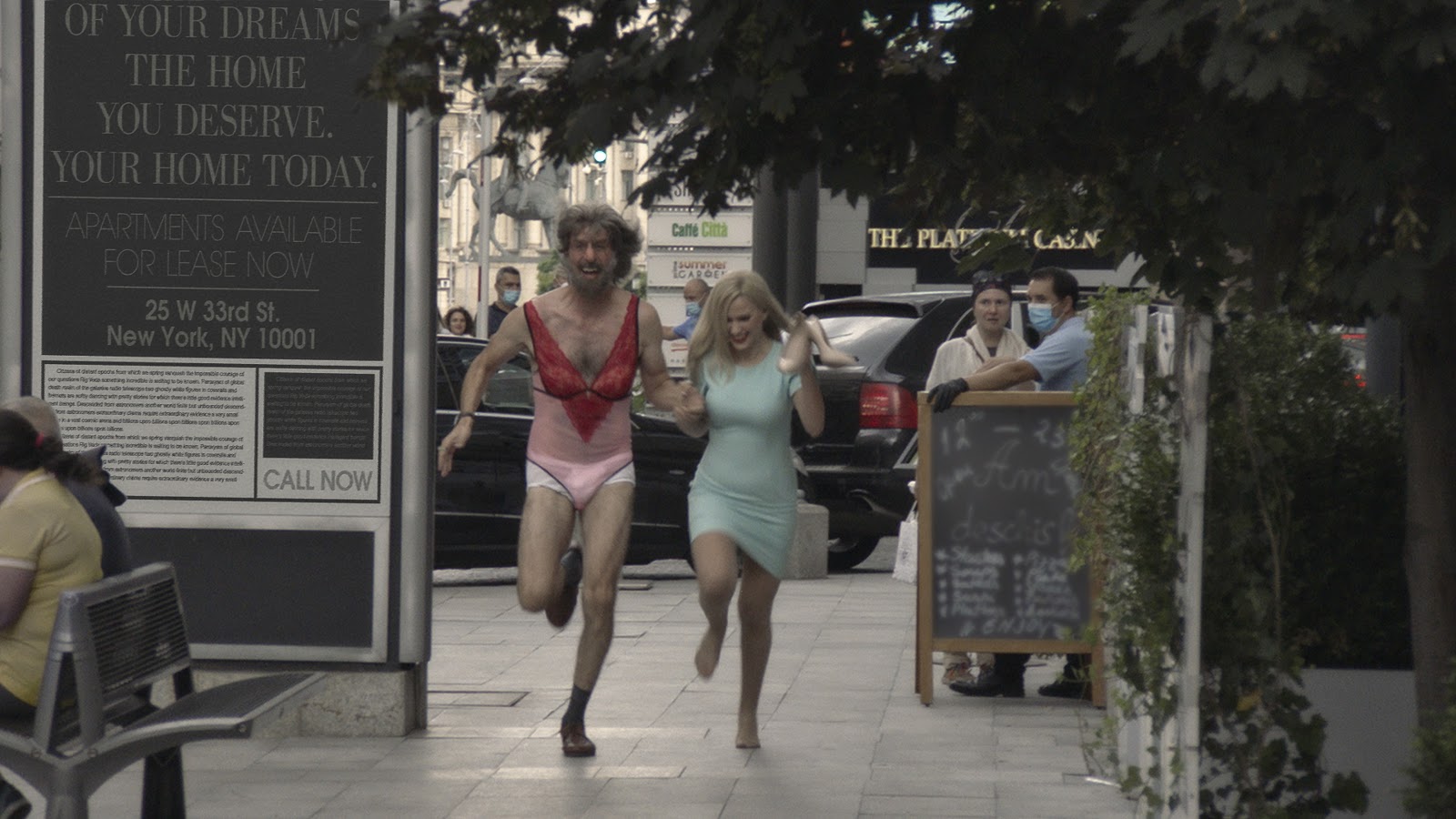
HULLFISH: I would think that the notes for this are different than for a lot of films because on other films, other than some that are sequels or cereals, you’ve got a crew that’s come together to do this one film and you don’t have the longtime collaborators, the history of knowing how something works, the person that knows how to rate the joke, and that kind of thing.
THOMAS: It was a definite shorthand that everyone had, and Jason, our director, had come from that world in terms of that style of comedy so he started right in. Monica Levinson, our producer, Anthony Hines, one of our other producers, they’re all people who fully understand that process. Like Craig said, we would get reams of notes from people. If you look at the Oscar nom for adapted screenplay for this film, I think there are at least 10 writers, and they would all be giving us notes, but ultimately Jason and Sacha were the ultimate filter in terms of yes or no.
HULLFISH: Did those notes also first come to the three of you and the three of you decided what the notes were as a unit?
GIAMBRA: They were being filtered through Sacha and Jason. I think there was a chain going between them, and then you got a definitive, “Let’s do these notes.” Or maybe we’d try presenting alternate versions of scenes. Maybe Jason wants to try this version of this scene, we presented it to Sacha, he’ll decide whether he wants to use it or not, but usually after it’s been filtered by a few different people, we’ll get a definitive list of notes.
THOMAS: We were using Google Docs for that. The notes were coming from Sacha, then our assistants would copy and paste them and put them into a Google document. We all had colors that we had assigned ourselves, and so Mike would jump on something, Craig would jump on something and, as we did them, we would just check them off. Again, being remote, it was a very efficient way of knowing who was doing what and of tracking that stuff with the assistants.
HULLFISH: So, the colors were used in Google Docs, not in your timeline?
ALPERT: Exactly. Just specific to the Google Docs. We each have a color so I knew Craig had taken care of the notes on the CPAC, or I knew Mike had taken care of the notes on another scene. It was a good way of working.
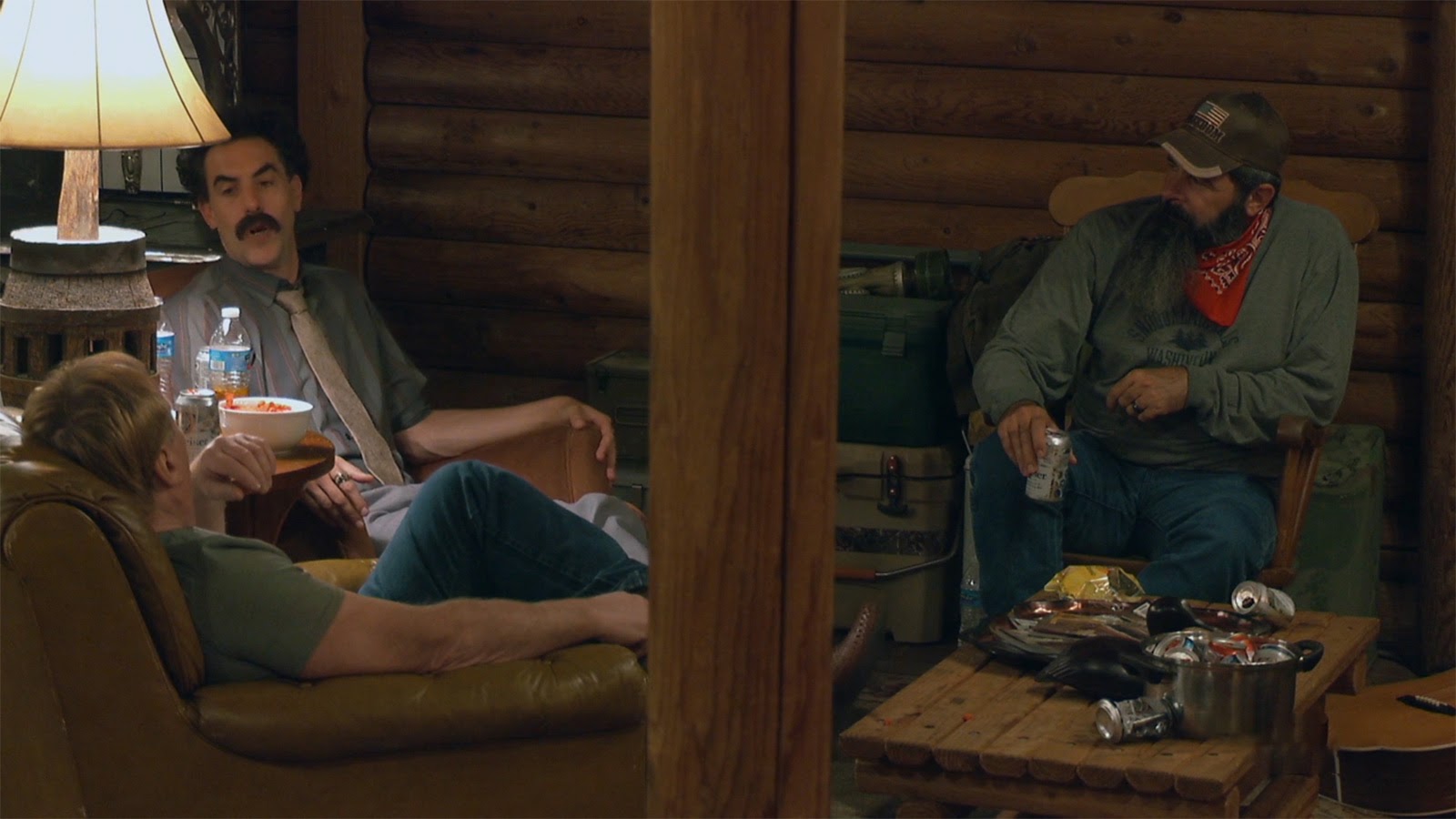
HULLFISH: Gentlemen, thank you so much for your time. I laughed hysterically, and I am ashamed to say that I did not see the first Borat movie, so this one was a revelation to me. Now I’ve got to go back and watch the first one.
THOMAS: Well, hopefully that’s a treat waiting for you. I hope you enjoy that one as well.
ALPERT: Thanks.
GIAMBRA: Thanks, Stephen.
THOMAS: Cheers.

